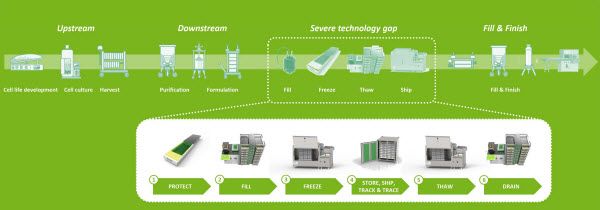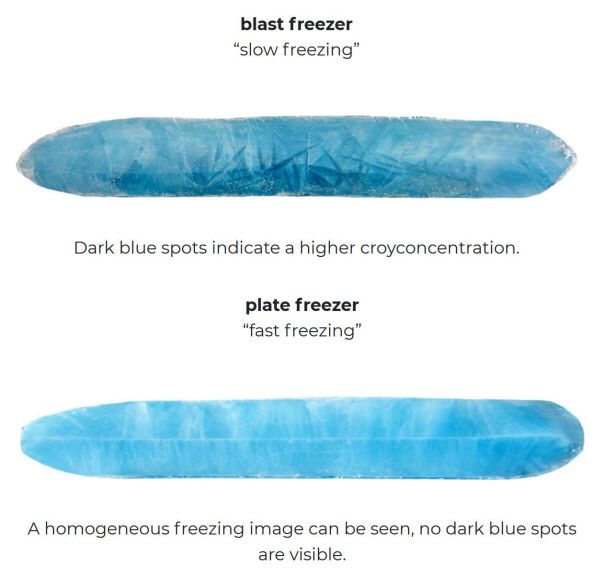Challenges in Bulk Drug Substance Management.
Biopharma Insights—Thought Leadership from Marketers | Paid Program
Final liquid drug substance production and fill–finish activities rarely occur at the same site. Nearly all pharmaceutical and biotechnology companies outsource a portion of their fill–finish needs to contract manufacturing organizations (CMOs) to help them address unexpected demand, satisfy second source policies, or better match scale with need.
Final liquid drug substance production and fill–finish activities rarely occur at the same site. Nearly all pharmaceutical and biotechnology companies outsource a portion of their fill–finish needs to contract manufacturing organizations (CMOs) to help them address unexpected demand, satisfy second source policies, or better match scale with need (1). Thus, the shipping of liquid drug substances worldwide is often inevitable as well as filled with challenges and complexities.
Figure 1. Single Use Supports BULK.STREAM closes the gap between downstream and fill-finish.

Common supply chain challenges
Proteins or monoclonal antibodies with highly complex structures require cold chain handling. Insufficient freezing of these substances not only renders them ineffective, but also harmful and possibly even life-threatening to patients (2).
Figure 2. Blast freezing versus plate freezing.

Many sets of hands are involved in packaging, lifting, hauling, and delivering products thus creating great potential for human errors. In addition, numerous challenges and complexities must be overcome throughout the supply chain to comply with good distribution practices as well as governmental and other regulations (3, 4).
How to Streamline the Biopharm Supply Chain
BULK.STREAM® from Single Use Support closes the gap between downstream and fill–finish activities with a new, secure management process for liquids (Figure 1). Using single-use bags and plate-freezing, BULK.STREAM® guarantees fast and safe protection, filling, freezing, storing, shipping, and thawing of high-quality substances from one set of hands to another. The single-use bag agnostic technologies increase patient safety and minimize the risk of biocontamination and product loss toward 0%. BULK.STREAM® also enables the storage and shipment of high-quality substances in a faster and more secure manner, and at a lower loading volume than to date.
Protect: A Robust Storage and Shipping (RoSS) shell protects every single-use bag available through BULK.STREAM. Its sophisticated construction offers many advantages (www.susupport.com/en/bulk-stream/ross).
Fill/Drain: RoSS.FILL is a flexible, fully automated platform for the allocation and distribution of bulk drug substance in single-use bags in RoSS shells (www.susupport.com/en/bulk-stream/ross-fill).
Freeze/Thaw: RoSS.pFTU is a plate-based freeze and thaw platform that offers safe and consistent freezing of high-quality substances in various scales (www.susupport.com/en/bulk-stream/freeze-thaw).
Store/Ship/Track & Trace: RoSS.SHIP is a highly robust, stackable, and coolable device that holds up to 20 RoSS trays for storage and shipping of frozen substances in a protected manner (www.susupport.com/en/bulk-stream/ross-ship).
HOW TO OVERCOME CRYOCONCENTRATION
Freezing drug substance is essential for storing and shipping, but the process stresses the protein and can lead to denaturation. Cryoconcentration leads to factors that induce protein denaturation. For example, the high protein concentration itself causes denaturation through protein aggregation (5, 6).
The solubility of the dissolved buffer salts decreases as temperature decreases. As freezing proceeds, ice formation excludes solutes (including protein) from the growing ice crystal. Solutes migrate in front of the growing ice that consist of small finger-like projections called dendrites (7, 8). These dendrites trap some solutes as they grow, so solutes are found in all regions of the block instead of only at the last point to freeze. As the solution trapped between dendrites freezes, however, it continues to undergo cryoconcentration as the water component is removed and as ice and the composition changes.
Cryoconcentration can never be eliminated, but with “controlled freezing,” geometry and freezing rate are determining factors in practical systems of freezing (9). Using a slow freezing rate leads to a high cryoconcentration with a comparable low ice surface. The low freezing rate causes the ice to form slowly enough for the proteins to be pushed along the ice rather than being trapped by it. Exposure to concentrated solutes can result in a loss of a protein’s thermodynamic stability, eventually causing aggregation.
Freezing rates that are too high lead to the opposite effect, namely a dendritic ice surface. The dendritic structure envelopes proteins in low cryoconcentrations, but compared with a plane ice front, the surface of the dendrites is larger.
Studies have shown that plate freezing technology achieves the best results because the fast freezing process hinders the accumulation of proteins and antibodies in the center of the bag. As demonstrated with blue color agent in Figure 2, slow freezing leads to cryoconcentration. When comparing the freezing results of static freezers vs. plate freezers, it is evident that fast freezing achieves more homogenous freezing and prevents excessive cryoconcentration.
HOW TO COPE WITH SCALABLE MARKET DEMAND
Small volumes of drug substance are often produced for early-stage clinical phases. Traditionally, the use of single-use drug substance bulk freezing containers has been the norm for the 50 mL to 1 L range. While this size offers an acceptable operational fit for dispensing drug substance for smaller-volume pharmaceutical manufacturing processes, it is not ideal for larger-volume dispensing processes. It is typical for commercial programs to generate several hundred liters of drug substance per batch, for instance (10).
BULK.STREAM, an end-to-end solution for all scales, addresses these challenges by freezing large volumes of expensive drug substances in batches to facilitate the production of medicinal drugs based on real-time commercial or clinical requirements. Cleaning, sterilization, and repeating documentation are not needed with single-use systems. Moreover, the RoSS platforms represent flexible, fast, and scalable solutions that help decrease the risk of contamination and increase patient safety.
In general, awareness of the gap in bulk drug substance management (between downstream and fill–finish) is steadily increasing. Securing the highest possible standard is not only important in terms of efficiency, but also for safeguarding high-quality products for patients (11).
References
- Liu C., Downey, W.: Biopharma Contract Fill-and-Finish Market Trends. Contract Pharma, 2019.
- Sykes, C.: Time- and Temperature-Controlled Transport: Supply Chain Challenges and Solutions. 2018.
- Markarian J.: Understanding risks in pharmaceutical shipping. Pharmaceutical Technology. 2015 39(8):52–54.
- Tennermann J.: Cold chain for beginners, Pharm Pro 2012.
- Singh, S. et al.: Large-Scale Freezing of Biologics; BioProcess, 2009.
- Zippelius; Untersuchungen zum Einfrier- und Auftauverhalten pharmazeutischer Humanproteinlösungen im Großmaßstab; diss 2002.
- Wisniewski R., Wu VL.: Large-Scale Freezing and Thawing of Biopharmaceutical Products. In: Avis KE, Wu VL, ed. Biotechnology and Biopharmaceutical Manufacturing, Processing, and Preservation, Vol 2 of Drug manufacturing technology series: CRC Press, 1996, p.7–60.
- Muldrew K. et al.: The water to ice transition: Implications for living cells. In: Fuller BJ,
- Benson EE, Lane N, editors. Life in the frozen state. Boca Raton, FL. CRC Press; 2004, p. 67–108
- Entegris: Employing Single-use Technology to Control Frozen Bulk Drug Storage: The Cold Hard Facts. Whitepaper, 2018.
- Pharmaceutical Commerce: Global biopharma cold-chain logistics will hit $15.7 billion in2019, 2019. Available at: https://pharmaceuticalcommerce.com/cold-chain-focus/global-biopharma-cold-chain-logistics-will-hit-15-7-billion-in-2019/. [Accessed February 18, 2020]
For more information, download the full white paper here.
Michael Eder is marketing manager at Single Use Support.
Mastering Antibody-Drug Conjugates
December 19th 2024In this episode, we explore BIOVECTRA’s capabilities in antibody-drug conjugate (ADC) manufacturing, from complex conjugation chemistry to synthesis of highly potent payloads. We’ll also showcase how BIOVECTRA’s extensive experience in complex chemistries and specialized small molecule manufacturing gives them a unique perspective, strengthening their approach to ADC production and ensuring clients receive custom solutions across all project stages.